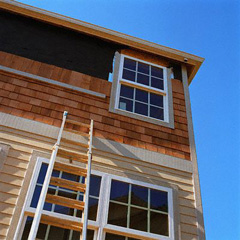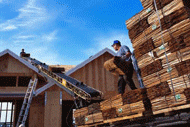Roofing and Shingles Contractor
All homeowners know that proper roofing is the best protection for a house. However, knowing when to replace a roof and with what type of roofing material is often a difficult decision. Roofing shingles come in many styles and are made of many different materials. There are also available from roofing suppliers different roofing systems such as steel roofing, copper roofing, slate roofing and composite roofing systems. Many homeowners choose metal roofing which provides excellent long lasting protection or slate roofing which provides a pleasing aesthetic appearance. Most homes today have modern asphalt shingles that come in many varieties that provide different looks in the form of architectural shingles.
All of these roofing concepts must provide an environment that sheds water quickly and efficiently from the structure.
 Knowing when to install a new roof or to begin a roofing repair is important information. If your asphalt shingles are brittle looking or curled at the edges you will be faced with stripping the old shingles and replacing them with new shingles or other roofing material. If the shingles are in good shape an "overlay" with new material may be all that is needed. If your roof is leaking that calls for immediate action and contact with a qualified roofing contractor or a representative from a roofing manufacturer. Here you can get a good understanding of the roofing cost and the benefits of the different roofing systems and options available. Gaining a strong understanding of roofing products and where you can obtain the proper roofing supplies will be important. Knowing when to install a new roof or to begin a roofing repair is important information. If your asphalt shingles are brittle looking or curled at the edges you will be faced with stripping the old shingles and replacing them with new shingles or other roofing material. If the shingles are in good shape an "overlay" with new material may be all that is needed. If your roof is leaking that calls for immediate action and contact with a qualified roofing contractor or a representative from a roofing manufacturer. Here you can get a good understanding of the roofing cost and the benefits of the different roofing systems and options available. Gaining a strong understanding of roofing products and where you can obtain the proper roofing supplies will be important.
This site has been designed to provide homeowners with valuable roofing information whether it be for engaging a roofing contractor or for do it yourself roofing projects.
Discover the ultimate selection of Premium Quality Bongs at unbeatable prices with our bong Sale in Australia. At bonglifeaustralia.com, we prioritize Fast delivery, ensuring You receive your products quickly and efficiently. Explore our diverse range of stylish and functional Bongs designed for every enthusiast. Elevate your smoking experience today and enjoy the convenience of shopping with us!
Home | Quote | Resources | Sitemap | About Us
© 2003-
, Roofing-Shingles-Contractor.com, All rights reserved. Privacy Policy

Web Site Exchange
|

Affiliate Partnership
|
|




